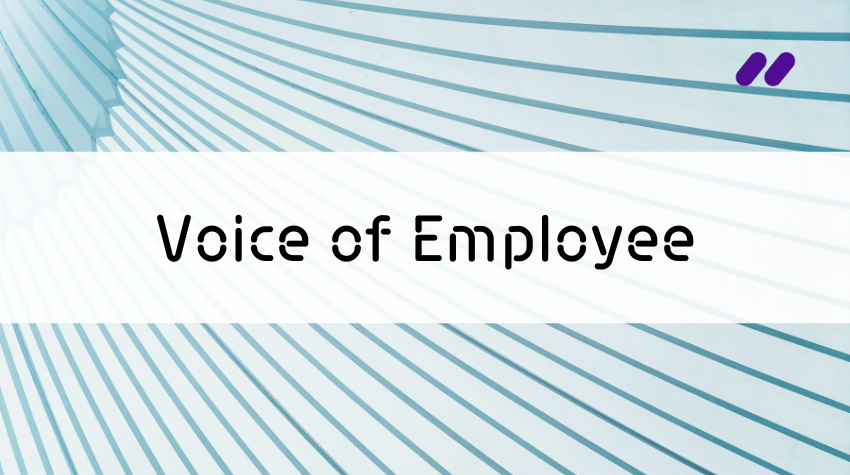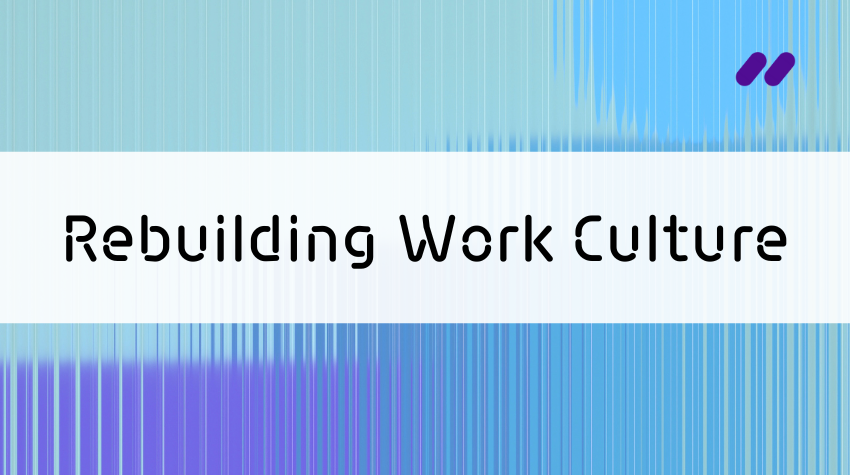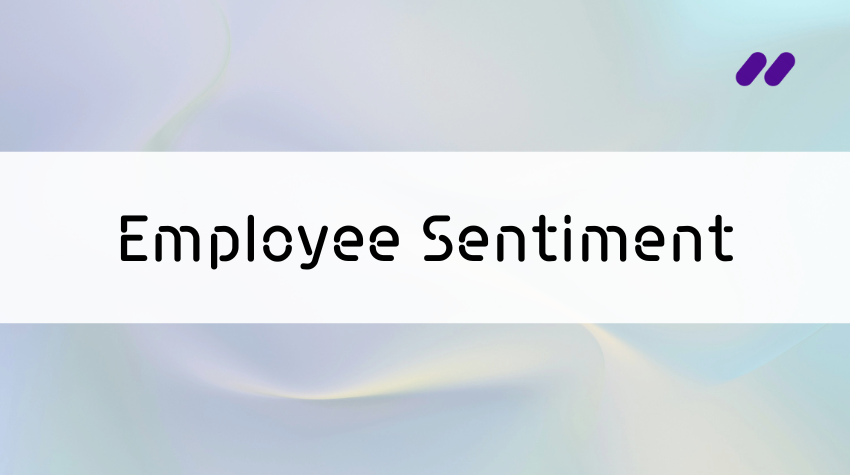As an HR leader, you’re well aware of how the pandemic has shifted your responsibilities. Changes keep on coming. They’re challenging to foresee and navigate, and you’re wondering how best to approach them all. Both strategically, to stay on top of HR best practices and employee needs, and technologically, with ongoing innovation in HR analytics.
This post considers the impact of the pandemic and, more recently, economic circumstances that are reshaping how HR leaders react to pressures from both within and outside of their company. And don’t worry, the phrase “new normal” is nowhere to be found in the coming sections. You can Ctrl-F if you don’t believe me.
What is the voice of employee and people analytics?
Voice of employee
The voice of employee (VOE) refers to all the feedback that you get from your employees. Anything from “The coffee machine in the break room is broken” to “I feel like I’m not growing in my career” can have an impact on individual employee satisfaction and wider company culture.
Proactive managers and HR leaders pay attention to how their employees are feeling to make sure that they are supported and not at risk of disengaging. A voice of employee program is simply a structured way to do a pulse check, by defining how to collect, listen, and respond to employee feedback. These programs support productivity and retention, and strengthen the trust between managers and employees.
The objective of listening to the voice of the employee is ultimately to improve employee engagement. Rather than guessing what’s on your employees’ minds, you can hear it directly from them. Employees want to be heard, especially if they are unhappy. VOE programs are a great way to make that happen.
If you understand the root cause of employee dissatisfaction, you can take more informed, data-driven steps to solve these issues. Initiatives backed by VOE insights are aligned with how people at your organization are really feeling. Taking these steps shows employees that you care about what they have to say and that their feedback makes a difference.
For both the voice of employee and the voice of customer, a feedback loop is the foundation of the program. People provide input, and the organization takes that and builds it into practice. Then, feedback is collected again about these new practices, which “closes” the feedback loop (and starts a new one).
People analytics
Another term you will come across is people analytics. Like a voice of employee program, it involves the collection and analysis of employee data in order to improve experiences. The difference is that while VOE programs are mostly concerned with open-ended data from employees, people analytics looks at all the data available to the organization.
This data can be outside the direct voice of the employee, like hiring data and salary information. People analytics sees recruiting, hiring, onboarding, ongoing training, milestone recognition, and career development all as part of the employee experience.
HR leaders like you hope to see the employee experience from a holistic perspective, too. Both VOE programs and people analytics can provide important business insights, and enable you to find patterns in your data that inform initiatives to improve employee well-being.
Of course, modern work post-pandemic has brought a set of new challenges like remote and hybrid office models and economic uncertainty. Without careful, employee-centered approaches, workplace decisions can erode trust between employers and the people they depend on. That’s why listening to the voice of employee matters greatly today.
Why the voice of employee matters
We have been seeing great shifts in the modern workplace over the last few years. First, the pandemic pushed employees out of the office to work from home, and it is clear today that these remote and hybrid models of working are here to stay. Now, economic conditions are putting pressure on employees, HR leaders, and managers alike to deliver more with less.
All this comes at a time when digital transformation is remodeling how we work, the tools we use, and the roles we take on within our companies.
Listening to the voice of employee is no longer optional. It is the strategy needed to adapt to the shifting HR landscape and stay profitable. By looking at the major challenges facing HR leaders today, we can explore how the voice of employee helps to pave the way forward.
Stats in the following sections are from Inspirus: 2024 Employee Engagement Trends & Forecasts and Gartner: Top 5 HR Trends and Priorities for 2024.
Hybrid and remote work
In the pre-pandemic work era, a centralized office culture was how everyone worked. With this model, it was relatively easy to build a sense of belonging, and collaboration among employees was natural.
This way of working was defined by a few characteristics:
- Company culture was created in and around the office
- Employees felt seen through physical closeness
- Coworker relationships were created through large-group experiences
Simply put, the physical closeness of coworkers and the overall office vibe contributed a lot to employee well-being and productivity. The office was the central transmittor of company culture.
In the traditional office model, employees were both aligned and connected with the company culture. Alignment is about seeing a clear mission, values, and culture of the organization. Connectedness is about identifying with that culture, and feeling that you belong to it.
Today, remote and hybrid work have disrupted this model, and the connectedness that comes with it. Without the consistency of an office, employees may feel unseen, which leads to disengagement. Even if they see what the company is trying to do to rebuild the culture, nevertheless they may not actually feel part of it.
This is one of the most central problems faced by organizations today. Keeping the traditional model of the office as the central transmittor of company culture is not practical. In light of employee resistance to return-to-office mandates, the model clearly needs to adapt to a new reality.
Or better yet, a new model needs to be formed. Forward-thinking HR leaders and managers are already building connectedness at their organizations in other ways.
Consider the following characteristics of the remote work model:
- Company culture is created through intentional collaboration with one another
- Employees feel seen and supported through emotional, rather than physical closeness
- Coworker relationships are built and strengthened through small-group experiences
These are opportunities to connect employees without the centralized office space, that leverages the unique qualities of remote work, and frames them as advantages rather than obstacles.
How do you rebuild a company culture around these new opportunities? At the very least, you can look to your employees for guidance. Ask for authentic feedback about proposed and implemented changes. Build a culture together over time that your employees are not only aligned with, but feel connected to.
Economic uncertainty
We have seen the effect of changing economic conditions today, in the form of layoffs and budget restrictions. Executives are pushing leaders and the employees they are responsible for to “do more with less” — a difficult charge for even the best managers.
Burnout is high. Inspirus reports that 3 in 4 employees and half of managers experience burnout. Overextended leaders are trying to get more from overextended employees… you see the problem. Altogether, trust between employees and managers is at an all-time low: Gartner reports that only 50% of employees trust their organization.
Worse, remote work contributes more to the eroding of this trust. Managers and executives worry about how less oversight might have an effect on productivity. The same goes for retention. Inspirus reports that 26% of employees are likely to change jobs in the next year (up from 19% in 2022).
As hiring budgets are pinched, the investment in hiring, training, and onboarding becomes much greater than retaining and upskilling existing employees. Ultimately, profitability drivers like margin, productivity, and efficiency may be the biggest pressures from executives. But a people-first culture is necessary to achieve any of those in the modern workplace.
Part of the underlying problem is misalignment. While HR leaders may be more concerned with employee well-being, executives may be concerned with productivity, retention, and ROI. As business metrics, these are useful. As a lens to look at the people you depend on, less useful.
The solution is a people-centric culture. Changing the organizational mindset to a people-first culture allows HR leaders to connect employee engagement with profitability. This important connection goes a long way in executive decisions.
Of course, the foundation of a people-centric culture is the voice of employee. VOE programs are important here to understand how employees are feeling. You can get a sense for the relationship between employees and the company, and the level of trust — or tension.
HR digital transformation
On top of these challenges that HR departments are struggling with, there is also the consideration of new technology. HR digital transformation looks to technology solutions to take some of the burden off the shoulders of HR leaders.
Technology is a great opportunity for HR teams, but digital transformation is extremely complex and requires a lot of work and research. HR leaders might not have the time, skills, or evaluation frameworks to properly lead a full digital transformation.
Already overwhelmed and stretched thin, it’s hard to expect HR leaders to know how to be on top of this. Still, there is pressure from executives to automate tasks and reduce costs as much as possible in the current economy.
What HR leaders do know for sure is that there is a lot more employee feedback data today. With remote and hybrid work, employees are interacting with their workplaces over digital channels. In an HR landscape driven more and more by analytics in light of the push toward digital transformation, this brings some relief to HR leaders trying to keep up.
As we navigate the HR landscape in the post-pandemic era, technology stands out as a crucial ally, empowering HR leaders to adapt and thrive. Considering the significance of the voice of employee that we have seen, the most impactful technology solutions may be text analytics software.
Closing the employee feedback loop with text analytics software
Adoption of new technology is a priority for HR leaders in 2024. Two things may be contributing to this. First, pressure to do more with less often goes hand in hand with automation led by technology adoption. Second, new capabilities of AI are pushing the boundaries of what is possible with technology.
At the end of the day, HR leaders are concerned with what employees are saying and feeling, and how to act upon it. Are there patterns, trends, emotions, or topics that need be addressed? Insight into how employees are feeling and why is the foundation of modern HR leadership.
In any feedback collection process, the business objective today is to close the feedback loop. Rather than feedback collecting dust in a database, organizations are taking steps to act on it. Not only that, but to communicate those steps with employees and continually ask for more feedback at every step.
Technology like text analytics software already helps HR leaders monitor feedback at scale. This is a technological advantage that ultimately leads tied to a better understanding of employee engagement and satisfaction through data analytics.
By automating the analysis of text-based employee feedback, HR leaders are freed up to do less manual tasks. And of course, the result of the feedback analysis is a large pool of insights to dip into when crafting recommendations to solve today’s workplace challenges.
So, how do you close the feedback loop with employees, and how do text analytics solutions support this important process? Let’s look at each step involved.
1. Gathering feedback
A major outcome of the shift to hybrid and remote work is that the volume of available employee data is much larger. While at home, employees are engaging with HR leaders and providing feedback to the organization primarily through digital channels.
The transition from office to remote work during the height of the pandemic also made it more of a priority for organizations to establish better feedback channels with employees. This was necessary as a change management strategy.
Unlike traditional office feedback mechanisms that happened in-person with less records, digital feedback is more structured for analysis. There is a record of text data, call transcripts, and other forms of data that are extremely useful for long-term VOE analysis.
Types of digital feedback from employees are:
- 1-on-1 meeting transcripts
- Focus group transcripts
- Employee forum discussions
- Slack or message channels dedicated to receiving feedback
Wherever your feedback is coming from, you can consolidate it to identify insights across all channels. If you’re just starting to collect employee feedback, asking open-ended questions in employee surveys is a great initial approach.
As we will see in the coming section, the advantage of having a text analytics solution is that you are not limited by large volumes of text data. So, you can encourage open-ended feedback without worrying that you won’t be able to analyze it.
2. Analyzing feedback
Text data is notoriously difficult to analyze manually. Text analysis is a field of data science that uses machine learning techniques to analyze large amounts of text data. The goal is to be able to analyze text with the same nuance and contextual understanding as a human reader.
One of the most important elements of text analysis is the identification of sentiment and opinions. For business applications like the voice of employee, sentiment analysis is how HR leaders and managers can pinpoint:
- The overall sentiment of employee feedback
- Sentiment associated with a particular topic
Sentiment analysis as a part of a broader text analysis approach enables you to draw correlations between sentiment, opinions, themes, and topics in your voice of employee data. You can do a pulse check on whether overall employee sentiment is more positive or more negative. Beyond that you can drill down into a specific topic, say, “work-life balance”, and decipher the sentiment associated with that theme.
Text analytics software categorizes feedback for you and provides a more structured understanding of your voice of employee data. Insight discovery is made easier as the results of the analysis are prepared for you, without any of the heavy lifting. Plus, you avoid the bias and inaccuracy that comes with manual analysis.
Identifying insights from the voice of the employee is the crucial first step in closing the feedback loop. Once you’ve identified the key issues in your employee feedback, you can take more informed steps to resolve them.
3. Developing an action plan
The analysis of VOE data is where technology provides the most support in the form of automation. After that, the ball really passes to HR leaders and managers to develop an action plan based on the insights uncovered and the level of urgency needed in the organization’s response.
Rightly so, this step is pretty demanding for HR leaders. Responses should be carefully considered to prevent any further erosion in employee trust. New stakeholders from different departments will be brought in to implement changes. Executive approval may be needed for new initiatives.
As we’ve seen before, there can be some breakdown of vision between executives and the HR leaders and managers working on the ground with employees. In developing an action plan, HR leaders are in the best position to advocate for employee well-being and build empathy between other stakeholders and employees.
Data from the voice of employee can be used to build strong cases for a people-centric culture. You can draw correlations between employee well-being and profitability, retention, productivity, ROI, and so on — that are driving business decisions.
4. Implementing an action plan
After developing an action plan, the next step of course is to put it into practice. This could mean making changes in policies, procedures, leadership training, or other aspects of the organization.
At this point, it would be wise to consider change management. Change fatigue describes the disengagement of employees who are tired of constant changes in the workplace. Both the volume and pace of change can be overwhelming.
Gartner reports that only half of organizational transformations are successful. How can you be sure to avoid catastrophe? Transparency and open communication are still a must. You can also involve employees more in the implementation of changes to give them more agency and ownership of the process.
And of course, you want to close the feedback loop.
5. Collecting feedback on changes made
This final step is where you finally close the loop. Transforming employee feedback from unstructured text into real organizational change is no small task. You’ve come so far, and there’s only a few things left to do.
First, communicate with employees how their feedback was used by the organization. This is great for transparency and providing confirmation to employees that they are being heard. Second, ask for feedback about the changes made. When you close one feedback loop, you open a new one.
This recursiveness is a best practice for voice of employee programs. For one thing, it gives you more data about how changes are received by the people that they impact the most. But the real value is that it continually affirms to your employees that you are concerned with their well-being and implementing changes that meet a wide range of needs, which are often unforeseeable.
Being flexible as an organization and adapting to new workplace dynamics is the surest way to stay on top of HR best practices and all the uncertainty that comes with our world today. Admist changing economic conditions, innovation landscapes, and business priorities, you can stay prepared with a voice of employee program backed by strong text analytics.
Rebuilding company culture with text analytics
Read more insights on the state of HR in 2024.
Connecting employee experience to customer experience
Depending on your role, you might be interested to know how work like a voice of employee program impacts the overall performance of the business in areas such as customer experience – which is a huge driver of growth today.
Experience management at your organization is all connected. You can consider it like a model of concentric circles in which employee experience radiates out into the larger circle of customer experience.
On the surface, you would correctly guess that good employee experiences ultimately impact customer experiences. Happy employees are more likely to have better interactions with customers (in a service capacity for instance). And they will have a more people-centric view of customers when making decisions that impact customers.
Research by MyCustomer and Confirmit demonstrates that people-focused organizations concerned with employee experience see parallel improvements in customer experience. In particular, pairing VOE and VOC data improves employee engagement, customer satisfaction, service, operations, and product development. So, it seems that it’s a win-win all around.
This topic merits a larger article, but we wanted to touch on it briefly at the end of this one. It’s smart to consider how everything is connected at your organization. Forward-thinking HR leaders today are looking at the bigger picture of experience management and a people-centric organizational culture.





